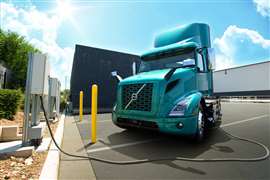Street Smarts: A crossroads for green trucks
03 August 2023
“We need fleets to start buying these products so we can scale this technology, justify our costs and bring prices down.”
If I heard that from an OEM or an engine builder once at the Advanced Clean Transportation Expo (ACT Expo) in Anaheim, Calif., last month, I heard it 100 times. Simmering frustration on the vehicle and engine side of the trucking industry is palpable. And understandable.
 The necessary zero-emission vehicle (ZEV) infrastructure is imperative if OEMs’ investment in ZEVs is going to pan out. (Photo: Volvo VNR/Volvo Trucks)
The necessary zero-emission vehicle (ZEV) infrastructure is imperative if OEMs’ investment in ZEVs is going to pan out. (Photo: Volvo VNR/Volvo Trucks)
Flash back just a few short years ago to when OEMs and engine builders were suddenly told that they were going to have to develop a whole new slate of zero-emissions vehicle (ZEV) technologies in an insanely short timeframe. No one was entirely sure they could do it.
But the OEMs rolled up their sleeves and got it done. They’ve delivered multiple products and developed entirely new technologies to meet the slew of California Air Resource Board (CARB) and U.S. Environmental Protection Agency (EPA) emissions mandates and deadlines.
A decade ago, hydrogen fuel cells were a futuristic tech you heard whispers about on the passenger car side. Today, many OEMs have long-haul hydrogen fuel cell tractors set to enter the market. The same is true for battery electric trucks (BEVs). A decade ago, no one believed BEVs could deliver anywhere near the kind of range required for even limited regional haul applications. Now, OEMs are in production with BEV trucks that can go in excess of 400 miles on a charge.
But no one is buying them yet – at least not in the numbers the OEMs need to scale these products.
That too, is understandable. On the fleet side, substantial pricing and operational concerns are hovering over the industry’s alternative fuels efforts like the smog that CARB is so determined to eliminate from California skies.
OEMs have invested literally billions of dollars in these new vehicles and drivetrains. That means that – even with government grants and incentives – it’s all still wildly expensive compared to conventional diesel powertrains. For now at least.
But vehicle cost is only the beginning of concerns fleets have. Infrastructure – or, rather, the almost complete absence of infrastructure required to support ZEVs – is a much bigger problem that has many fleets frozen in their alt-fuel starting blocks. The costs associated with installing multiple infrastructures to support multiple alternative powertrains for both private and public use are staggering. Best-case scenarios are that it will cost hundreds of billions to make alt-fuel infrastructure a reality – and no one has any idea how all of this is going to work or who is going to pay for it.
 Jack Roberts is a Tuscaloosa, Ala.-based independent journalist and licensed commercial driver with more than 20 years’ experience covering the North American and global trucking industries.
Jack Roberts is a Tuscaloosa, Ala.-based independent journalist and licensed commercial driver with more than 20 years’ experience covering the North American and global trucking industries.
If you decide today that you’re going invest in your own private charging depot, your best-case lead time for getting that done is anywhere from 18-24 months. And that’s assuming that your local power utility is down with your project. Because – somewhat surprisingly – many are not.
So the mood at ACT Expo 2023 was very much akin to a standoff. The trucks are ready. But as Daimler Truck North America president and CEO John O’Leary warned during his keynote address, “We need utilities to act now to create a bare minimal standard of operability for electric trucks. California alone will need 5 million kW of installed electric capacity by 2035 for medium- and heavy-duty electric trucks. And if we ignore these requirements, we will find ourselves with a lot of orphaned equipment sitting idle at fleets and on factory floors that cannot be utilized to meet our zero-emissions future.”
Something needs to happen to break trucking’s alt-fuel stalemate. And that may very well happen when the next round of EPA diesel exhaust emissions regulations hit in 2027. Kenny Vieth, president and senior analyst at ACT Research, recently predicted that the regulations will drive the price of a new diesel truck up by as much as $25,000. Assuming that ZEV costs will continue to slowly drop over the next few years, it is possible that something approaching price parity between diesel and alternative drivetrain technologies may occur. But even then, if nothing significant has happened on the alt-fuel infrastructure front, that won’t be enough to turn large numbers of fleets away from diesel. After all, what good is a truck if you can’t run it?
Green trucking’s glaring problem is obvious – something big has to happen on the infrastructure front. And soon.
STAY CONNECTED



Receive the information you need when you need it through our world-leading magazines, newsletters and daily briefings.
CONNECT WITH THE TEAM





